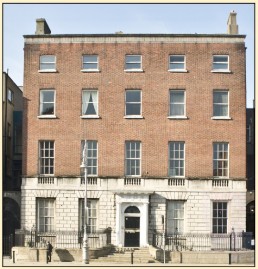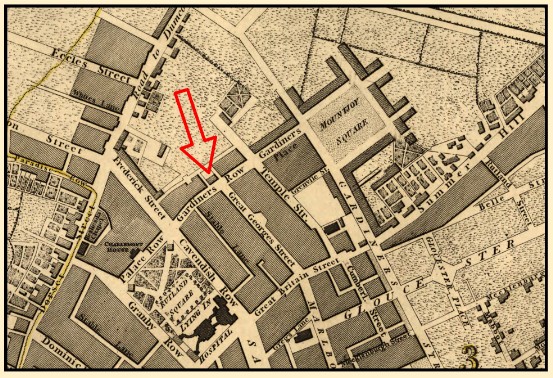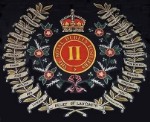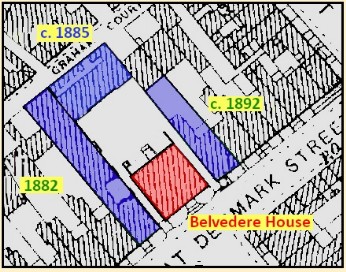Belvedere College
James Joyce finished his primary schooling and obtained all his secondary schooling at the Belvedere College of St. Francis Xavier, now simply Belvedere College. The school was founded by the Irish Society of Jesus in 1832 at the disused Jesuit chapel at 37-38 Hardwicke Street. The building was previously a convent of the Poor Clare Sisters who in 1821, relocated to a much larger facility in Harold's Cross, Rathmines. They surrendered the Hardwicke Street property to the Jesuits who used it as a chapel. The Jesuits relocated their chapel in 1829 to the newly built St. Francis Xavier Church. In Ulysses, that new church building was Fr. Conmee's chapel on Gardiner Street Upper. On Bloomsday, at 37-38 Hardwicke Street was a National School.
Click on the link for a late 19th-century photograph of the first school-house; the light-faced building on the left. At the time, it was likely the proprietary school of Samuel Bowden (Thom's Directory, 1883). The image is on a Twitter thread of the Dublin Civic Trust and will appear in a popup window.
The school soon outgrew its premises and in 1841, the Jesuits purchased its new home: Belvedere House at 6 Great Denmark Street. This location is only two blocks from St. Francis Xavier and its presbytery, and is where the school is situated today.
n/ George Newenham Wright, An Historical Guide to the City of Dublin (London: Baldwin, Cradock, & Joy, 1825), 94-95; Irish Jesuit Archives Catalog, IE IJA CM/GARD; website of Belvedere College; Thom's Directory - 1883, 1904.
Belvedere House
In the late 18th Century, the wealthy George Augustus Rochfort, 2nd Earl of Belvedere, commissioned the architect Robert West to build a grand town house on Dublin's then northern outskirts. The Earl's home was built on Gardiner's Row (Great Denmark St.) in 1786 at the immense cost of £24,000. His neighbors were the Lords Tullamore, Norbury, Erne, and Fingal, plus Sir Robert King, Bt., and Lady Hannah Stratford, sister to the Earl of Aldborough. (Click link for block plan in a popup window.) In Ulysses, Fr. Conmee thinks of Aldborough's Dublin mansion as he heads for the O'Brien Institute. The Earl participated fully in Dublin's political and social life and gained a reputation for magnificent entertainments at his city home. Rochfort died in 1811, childless, and the peerage became extinct. Four years later, his widow married the lawyer, Abraham Boyd.

Belvedere House, 2021.
In 1835, Lady Belvedere died and left her estates (annual income of £3,000 to £4,000) to her only child, George A. Rochfort-Boyd. At the time, he was a minor and did not come into his inheritance, which included Belvedere House, until March 14, 1838. Rochfort-Boyd did not like city life and on attaining his majority moved to the Belvedere manor house in Co. Westmeath and shuttered the Great Denmark Street mansion. He later sold Belvedere House to Sylvester Young, from whom it was purchased by the Jesuits. Young, who was active in Catholic charities, sold the property to the Jesuits in 1841 for £1,600, probably a below-market price.
n/ C. Scantlebury, "Belvedere House," Dublin Historical Record 13, no. 3/4 (1953); Saunders's News-Letter, May 29, 1839; Dublin Weekly Register, July 3, 1841.
Location of Lord Belvedere's Town House

Faden's Plan of Dublin, 1797 - New York Public Library.
For a view of the area prior to its development, click here for an extract from Jacques-Nicolas Bellin's 1764 Plan of Dublin. It is in a jpg on this website and will open in a popup window.
"The former Belvedere House, despite replacement brick walls and timber sash windows, retains its original appearance and detailing complete with a very fine Doric doorcase. Having also one of the finest eighteenth-century interiors in Dublin with extensive neo-Classical plasterwork by Michael Stapleton, Belvedere House provides one of the most dramatic vistas as it terminates the north end of North Great George’s Street, adding to the overall impression of this Georgian mansion. The late twentieth-century wings mimic the architecture of the earlier building and complement its setting."
n/ National Inventory of Architectural Heritage, Department of Housing, Local Government, and Historic Monuments, Republic of Ireland.
School Life
By 1800, demand for student places had grown and the Jesuits soon purchased adjacent properties to increase student capacity. Lord Fingal's former town house was acquired in 1882, and used, in part, for the school's new junior division (pupils aged 8-10). In 1884, the property at the schoolyard's rear was purchased and after renovation, that building opened c. 1885. Sir Robert King's old house at 7 Great Denmark Street was purchased sometime after 1891. Well before the time Joyce attended, Belvedere House had become the staff residence; the new buildings held the classrooms. Thom's Directory, 1904 shows living there are the rector plus five staff, all Jesuit priests. Pupils were only permitted in Belvedere House by rare, formal invitation. The boys, along with service personnel and tradesmen, entered the school grounds through the gated alleys on either side of the old mansion (former carriage-house gates).
While the Jesuit boarding school Clongowes Wood College catered to moneyed Catholics, Belvedere College was for sons of Dublin's lower-middle class. In 1841, the annual school fee was £12 12s. but by the time of Joyce's attendance, it was down to £9. There was considerable scope for negotiation; the school's fee books show a range of figures charged. For an 1841 newspaper advertisement that promotes the school, click here. It is in a pdf file on this website and will appear in a popup window.
Pupils were given a typical Victorian, classical education preparatory for university or schooling in the learned professions (clergy - seminary, legal - inns of court and articled clerkships, medical - medical school). As in all boys' schools of the time, corporal punishment for misbehavior was the norm. At Belvedere, the staff took a formal, ritualistic approach to punishment. A former student recalled:
"There was corporal punishment in the school, but it was carried out strictly in accordance with Jesuit regulations. The rule was that it could only be administered by the Prefect of Studies, as he was known. I witnessed tow people in that role in my time. One of them, I am fairly certain, hated giving corporal punishment. I don't think the other was worried about it one way or another, but I am not sure. That is just the impression I formed. It involved being slapped with a strap, and if you got a wallop of it, you felt it."
Part of the school's religious life was the Sodality of the Blessed Virgin Mary, an association of pious pupils dedicated to the Virgin Mary. Membership was by election of the existing members and the society was overseen by one of the school's Jesuit staff.
n/ Irish Times, February 5, 1883. Click on the link and the junior division advertisement will open in a popup window as a pdf. Note that in 1891, 7 Great Denmark Street housed law offices. Thom's Directory, 1892.Ciaran O'Neill, Catholics of Consequence (Oxford: Oxford Univ. Press, 2014); Louis McRedmond, To the Greater Glory: A History of the Irish Jesuits (Dublin: Gill, 1991), 163; Tom O'Donoghue and Judith Harford, Piety & Privilege (Oxford: Oxford Univ. Press, 2021), 169.
Joyce at Belvedere
James Joyce left Clongowes Wood after only three years attendance as his father could no longer afford the fees. For a little over a year, he was first home-schooled by his mother, then attended the Christian Brothers O'Donnell School on North Richmond Street. Joyce's father, through a chance encounter with Fr. John Conmee, managed to have his two eldest sons (James and Stanislaus) attend Belvedere College at no cost. Conmee had recently left his position of rector at Clongowes Wood to become the prefect of studies at the Jesuit's Dublin school. Eleven-year-old James entered Belvedere College in April 1893.
Joyce was the school's star pupil and excelled in English and foreign languages. For his high scores on the Irish Board of Intermediate Education standard examinations, he won state exhibitions in 1894, 1895 (payable over three years), and 1897 (payable over two years). He won school prizes from Belvedere in 1894, 1897, and 1898. While at Belvedere, his total scholarship earnings were £80, not a trivial sum.
Click image for a map from this website that shows
the Joyce homes. It will open in a popup window.
When Joyce entered Belvedere, he was deeply religious and contemplated the taking of religious vows. He was elected a member of Sodality in December 1895 and its prefect (student head) in September 1896.
While at Belvedere, Joyce gradually lost his religious leaning and after Easter 1897, no longer took communion. By the time he entered university in 1898, he was not a practicing Roman Catholic. When Joyce abandoned his former faith is not known as when later asked that question he replied, "That's for the Church to Say."
Exhibitions and Prizes at Belvedere
1894 | 1895 | 1896 | 1897 | 1898 | |
Intermediate School Board Exhibition | 20/-/- | ||||
Intermediate School Board Exhibition | 6/13/4 | 6/13/4 | 6/13/4 | ||
Intermediate School Board Exhibition | 15/-/- | 15/-/- | |||
Belvedere Prizes | 2/-/- | 3/-/- | 5/-/- |
Earnings for Year | 22/-/- | 6/13/4 | 6/13/4 | 24/13/4 | 20/-/- |
pounds/shillings/pence
n/ Kevin Sullivan, Joyce among the Jesuits (New York: Columbia Univ. Press, 1957); Leo M. Manglaviti, "Sticking to the Jesuits: A Revisit to Belvedere House," James Joyce Quarterly 37, no. 1/2 (Fall 1999): 214-24; Richard Ellman, James Joyce, Rev. Ed. (New York: Oxford Univ. Press, 1982), 35-56, 65.
A Senior-Year Credential, but with an Asterisk
In Ireland of the 1890s, there was no state-recognized credential for graduation from an intermediate school. The state did; however, offer examinations in intermediate school subjects, and through such examinations, made an official determination of who "passed" an intermediate school year.
The Board of Intermediate Education (Ireland) each year gave nation-wide examinations in several subjects tailored to each of the four, intermediate schooling years: Preparatory, Junior, Middle, and Senior. The following table shows the subjects Joyce studied at Belvedere and indicates for which ones there were state examinations.
Subjects Studied
English Latin French Italian | Intermediate Examinations |
Arithmetic Algebra Euclidean Geometry Plane Trigonometry | Intermediate Examinations |
Natural Philosophy Chemistry | Intermediate Examinations |
Geography History |
To receive a "pass" credential for a school year, a pupil had to pass examinations in English plus three other subjects. One of the three subjects had to be a foreign language, another had to be mathematical, and the third could be either mathematical or a language. Languages for which there were examinations were Greek, Latin, French, German, Italian, Spanish, and Irish. The mathematical subjects were arithmetic, algebra, geometry, and trigonometry. Though the Board of Intermediate Education offered examinations in other subjects, they did not count towards determination of a school-year pass.
While Joyce received passing marks for his Preparatory, Junior, and Middle school years, he failed to receive a "clean" Senior-year pass. Joyce took and passed the Senior English, Greek, and French examinations but failed the two Senior mathematics examinations he took (geometry and trigonometry). The Intermediate Education Board; however, applied his 1897 mathematics pass to his senior year ("M.Ex, '97") and accordingly, he did not receive a "Failed" for his Senior-year examination.
n/ Appendix, First Report of the Commissioners of Intermediate Education (Ireland), 1898, [C. 9117]; Sullivan, Joyce among the Jesuits, 236.
Joyce's Classmates of Note
Sons of Prominent Politicians
While Joyce was at Belvedere, also in attendence were sons of three Members of Parliament: Richard and Eugene, sons of Richard Sheehy, an anti-Parnelite Nationalist MP for South Galway. Christopher Joseph, son of Timothy Daniel Sullivan, an anti-Parnelite Nationalist MP for West Donegal. Charles Stuart Parnell, son of J. J. Clancy, a Parnelite Nationalist MP for North County Dublin.
Literary Character Models and Namesakes
Eugene de Courcy Lawless | Appears as himself in A Portrait. | |
Patrick Joseph Dwyer | Appears as himself in A Portrait. | |
James Lenahan | Namesake characters in "Two Gallants" Dubliners and Ulysses. | |
David Dominick O'Connell | His father was the caretaker of Prospect Cemetery, Glasnevin (Ulysses). | |
Thomas Francis Mallon | His father was the DMP Assistant Commissioner that Bloom mentions in the cabman's shelter (Ulysses). | |
Richard & Eugene Sheehy | Their mother meets Fr. Conmee in "Wandering Rocks" Ulysses. | |
J.F. Byrne | Model for the character Cranly in A Portrait and Ulysses. | |
Vincent & Albrecht Heron | Vincent Heron in A Portrait is a composite of these two. | |
William Fallon | Appears as himself in A Portrait. | |
Vincent Connolly James Shuley Peter Paul Ennis | In A Portrait, all accompany Dwyer and Stephen to the North Bull. |
n/ Sullivan, Joyce Among the Jesuits, 96-100; James Joyce, Dubliners (London: Richards, 1914); James Joyce, A Portrait of the Artist as a Young Man (New York: Huebsch, 1916).
Documents and Images on Other Websites
To view or download the file click on the link. Click on the icon for the homepage of the website that hosts the document or image. All webpages will open in new browser windows.
An issue of the school's magazine which began publication in 1909. From the digital collection of University College Dublin. Click on the icon for the UCD Digital Library home page.
In a 1.0 MB pdf on the school's website. Click on the icon for the timeline page which also offers a timeline of the Jesuits.
From the CARLI Digital Collections, Southern Illinois University. This digital image is the property of SIU and may not be used without the school's permission. Click on the icon for the digital collections' home page.
Taken by Shannon Chance, professor of architecture, in 2018 during the Irish Architecture Foundation's "Open House Dublin Day." From Dr. Chance's blog, Ireland by Chance. Click on the icon to the right for the "Open House Dublin" page.
Links to Other Websites
Note: The webpages will open in new windows.
Click on the link to go to that page of the website. Click on the icon to go to the website's home page.
"The College is a Catholic school under the trusteeship of the Society of Jesus. Set in the centre of Dublin city, it continues today a tradition since 1832 in the Jesuit approach to education." From the mission statement page of Belvedere College's website.
Article by Conor Lucey on the website of the North Great George's Street Preservation Society. Dr. Lucey teaches architectural history at University College Dublin.







